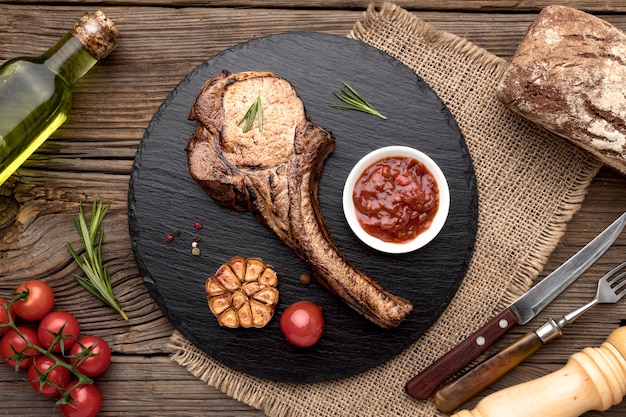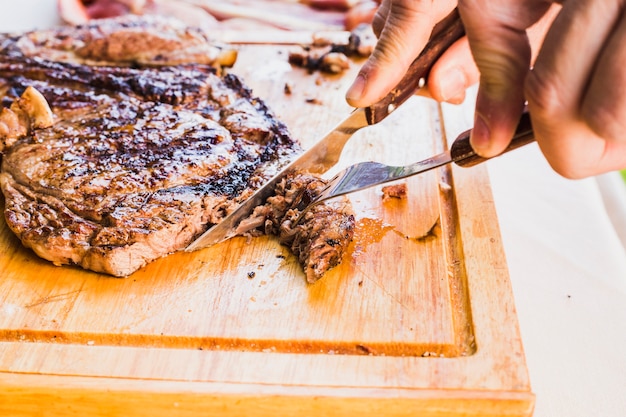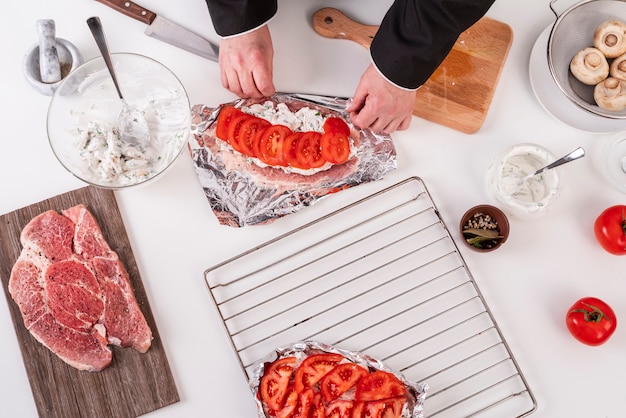Ah, the rib eye steak. A cut of beef that embodies pure indulgence, a symphony of flavour and texture that sends taste buds on a joyous journey. There's a reason it's a perennial favourite, and for me, the bone-in version takes it to a whole new level. The bone adds an extra dimension of flavour, a primal satisfaction that's simply irresistible. I've been grilling, searing, and baking rib eye for years, and trust me, there's a real art to getting it just right. So, grab a comfortable seat, pour yourself a glass of something good, and let's dive into the world of the perfect bone-in rib eye.
Part 1: The All-Important Cut

It all begins with the cut itself, doesn't it? You wouldn't want to try and build a magnificent castle with a pile of pebbles, would you? No, you need the right foundation, the perfect building block. And that's exactly what you have with a well-chosen rib eye. Forget those flimsy, supermarket-wrapped slabs that look more like a random slab of meat than a culinary masterpiece. We're talking about a true butcher-cut rib eye, aged to perfection, with a beautiful marbled texture that whispers promises of juicy, succulent flavour.
Picking the Right Rib Eye: A Connoisseur's Guide
Choosing a rib eye isn't just about grabbing the first one you see. It's an art, a discerning selection process that takes into account the finer details. Here's how to become a rib eye connoisseur:
- Marbling: The telltale sign of a top-notch rib eye is its marbling – those delicate streaks of fat woven throughout the meat. This isn't just for looks; it's what makes the steak melt-in-your-mouth tender and delivers that rich, buttery flavour. Imagine it like a juicy, flavour-packed mosaic.
- Colour: A good rib eye should boast a deep, rich red hue, with a subtle purple tint around the edges. This indicates freshness and proper handling. Avoid any cuts that look dry, pale, or have discolouration – they might not be as flavourful.
- Texture: The meat should feel firm and springy to the touch, a testament to its quality. It shouldn't be overly hard, which might suggest it's been dried out or over-aged.
- The Bone: Now, we come to the heart of the matter: the bone. A good bone-in rib eye should have a substantial, sturdy bone, signifying that you're dealing with a real cut, not some butchered-down remnant. The bone adds not only structural integrity but also an extra layer of flavour, a deep, earthy richness that permeates the meat.
Remember, investing in a high-quality rib eye is an investment in flavour. You'll notice the difference, I assure you.
Part 2: The Art of Seasoning

Now, you've got your perfect rib eye, the star of the show. But a great actor needs a great script, right? The same goes for your steak; it needs the right seasoning to shine. I'm a firm believer in simplicity when it comes to seasoning. No fancy rubs, no pre-mixed marinades. Just the classic duo of salt and pepper, allowing the inherent flavour of the meat to take center stage.
The Salt and Pepper Dance: A Simple Yet Effective Ritual
Here's my foolproof method for seasoning a rib eye:
- Salt it First: Generously salt the steak about 30 minutes before you plan to cook it. This allows the salt to draw out some of the moisture, creating a slightly more concentrated flavour profile and helping to form a beautiful crust during cooking.
- Pepper it Next: Just before hitting the grill or pan, give your rib eye a generous helping of freshly ground black pepper. It adds a subtle spiciness and a lovely aroma that dances with the smoky notes of the cooking process.
- Don't Overdo It: The key here is moderation. You want to enhance the natural flavour of the steak, not drown it out with an onslaught of seasoning.
Remember, less is more when it comes to seasoning, letting the natural beauty of the rib eye truly shine.
Part 3: The Cooking Game: Mastering the Art of Heat

We're finally at the heart of the matter: the cooking. This is where you truly get to unleash your culinary creativity, your mastery of heat, and your understanding of the rib eye's delicate dance with the flame. Now, there are countless opinions on the best way to cook a rib eye. Grilling enthusiasts swear by the smoky char, cast iron lovers praise the crispy crust, and oven aficionados tout the precision of their method. But I'll tell you this: there's no right or wrong answer. It all comes down to personal preference and the tools you have at your disposal.
The Grill Master: Embracing the Fiery Embrace
If you're a grill master, like myself, then the mere thought of a sizzling rib eye on those hot coals sends shivers of anticipation down your spine. Here's my secret to grilling perfection:
- Get it Hot: The key to a good grill cook is high heat. We're talking 500°F (260°C) – hot enough to sear those beautiful grill marks and lock in those precious juices.
- Sear It First: Throw the steak onto the roaring grill and sear each side for about 2-3 minutes. You'll see those lovely grill marks emerge, a testament to the heat's embrace.
- Cook to Your Liking: After the searing, lower the heat slightly and continue cooking to your preferred level of doneness. For a juicy medium-rare, aim for about 10-12 minutes total cooking time, but remember, every rib eye is different.
- Rest It: Don't rush the final act! Let your steak rest for 5-10 minutes before slicing and serving. This allows the juices to redistribute throughout the meat, resulting in a more tender and succulent steak.
The Cast Iron Charmer: A Classic with a Fiery Edge
For those who love the versatility of the cast iron pan, you're in for a treat. Cast iron delivers that exceptional sear, creating a crispy exterior that's a symphony of textures. Just make sure your pan is screaming hot before you even think about adding the steak!
- Heat It Up: Preheat your cast iron pan over medium-high heat for about 5 minutes. You want that pan radiating heat, ready to create a crusty masterpiece.
- Sear It Up: Add the steak to the screaming hot pan and sear for about 2-3 minutes per side. You'll see those beautiful grill marks appear, a testament to the intense heat.
- Cook It Up: After searing, reduce the heat to medium and continue cooking the steak for another 5-7 minutes, adjusting the cooking time based on your desired level of doneness.
- Rest It Up: Once the steak is cooked to your liking, let it rest for 5-10 minutes. This is essential for allowing the juices to redistribute, ensuring maximum tenderness and flavour.
The Oven Guru: A Precision Approach to Perfection
And for those who prefer the precision of the oven, the reverse sear method is a brilliant technique for achieving a perfectly cooked rib eye. It involves a long, slow cook followed by a quick sear, resulting in a steak that's cooked evenly throughout and boasts a beautiful crust.
- Low and Slow: Preheat your oven to 250°F (120°C). We're aiming for a gentle, even cook that transforms the steak without drying it out.
- Cook It Low: Place your steak on a baking sheet and cook for about 1 hour, or until the internal temperature reaches about 120°F (50°C) for medium-rare. Use a meat thermometer to monitor the progress, ensuring a consistent cook.
- Sear It High: Remove the steak from the oven and sear it on a hot grill or in a blazing hot cast iron pan for about 2-3 minutes per side. This creates that coveted, crispy crust that contrasts beautifully with the tender interior.
- Rest It: As always, let the steak rest for 5-10 minutes before slicing and serving.
Part 4: The Temperature Check: Your Guide to Doneness
No chef would dream of venturing into the kitchen without their trusty tools, and that includes a meat thermometer! It's the key to achieving the perfect level of doneness, ensuring a juicy, flavorful steak that's cooked exactly to your liking.
The Temperature Guide: A Precision Chart for Steak Success
| Doneness | Internal Temperature (°F) | Internal Temperature (°C) |
|---|---|---|
| Rare | 125-130 | 52-54 |
| Medium-Rare | 130-135 | 54-57 |
| Medium | 140-145 | 60-63 |
| Medium-Well | 150-155 | 65-68 |
| Well-Done | 160 | 71 |
Remember, the internal temperature will continue to rise a few degrees after you remove the steak from the heat. So, it's best to pull it off the grill or pan a few degrees earlier than your desired temperature to achieve your ideal level of doneness.
Part 5: The Ultimate Accompaniments: A Symphony of Flavours
Now, we've got our star performer, our perfectly cooked rib eye. But what about the supporting cast, the ensemble that elevates the entire culinary experience? I'm talking about the side dishes, the culinary companions that bring out the best in our rib eye, creating a harmonious blend of textures and flavours.
Sides that Shine: A Culinary Ensemble
Here's a taste of my favourite side dish pairings:
- Roasted Vegetables: roasted asparagus, broccoli, Brussels sprouts, or root vegetables like carrots and potatoes are a classic choice. Roasting intensifies their natural sweetness and creates a lovely, caramelized texture that complements the richness of the rib eye. Think of it as a colourful counterpoint to the star of the show.
- Creamy mashed potatoes: A quintessential comfort food, mashed potatoes with a generous knob of butter and a splash of cream, are a creamy dream. They provide a lovely contrasting texture to the juicy steak, melting in your mouth like a warm embrace.
- Garlic Bread: Freshly baked garlic bread, bursting with the aroma of garlic and herbs, is a must-have. It's the perfect vehicle for soaking up those delicious juices from the steak, providing a final flourish of flavour.
- Sautéed Mushrooms: Sautéed mushrooms with garlic and herbs add a lovely earthy flavour that harmonizes beautifully with the richness of the rib eye. It's a simple yet sophisticated touch that elevates the entire dish.
- Green Salad: A simple green salad with a light dressing is a refreshing contrast to the heavier flavours of the steak and sides. It cleanses the palate and adds a touch of lightness to the overall experience.
The best side dishes are those that play off the flavour and texture of the rib eye, creating a culinary masterpiece that satisfies both the palate and the soul.
Part 6: The Finishing Touch: Elevating the Ordinary to the Extraordinary
We've reached the final act, the crescendo of our culinary journey. It's the moment where we add those finishing touches that take our already delicious rib eye to a whole new level, transforming it into a truly extraordinary experience.
Finishing Touches that Elevate: The Grand Finale
Here's how to add that extra touch of magic:
- Butter: A generous pat of butter, melting on top of the hot steak, creates a rich, creamy sauce that adds a touch of decadence and amplifies the flavour of the meat. It's a classic technique that never fails to impress.
- Garlic: A sprinkle of fresh garlic flakes adds a pungent, aromatic flavour that dances beautifully with the richness of the steak. It's a simple yet effective way to boost the complexity of the flavour profile.
- Herbs: Fresh herbs like thyme, rosemary, or parsley add a burst of freshness and aroma that complements the smoky notes of the steak. Experiment with different combinations to find your perfect blend.
- Red Wine Sauce: A rich, velvety red wine sauce is the perfect complement to a rib eye. The acidity of the wine cuts through the richness of the steak, creating a harmonious balance of flavours. And the best part? You can easily make your own with a few simple ingredients.
These finishing touches transform your rib eye from a good meal into a truly memorable culinary experience.
Part 7: The Drinks that Pair: The Perfect Liquid Companion
Now, no culinary journey is complete without a suitable libation. What could possibly pair better with a perfectly cooked rib eye than a drink that enhances its flavour and complements the overall dining experience?
A Sip of Perfection: Elevating the Culinary Experience
Here are a few of my favourite pairings:
- Red Wine: A full-bodied red wine like Cabernet Sauvignon, Merlot, or Shiraz complements the richness of the steak. The tannins in the wine stand up to the meaty flavours, while the fruitiness provides a delightful contrast.
- Beer: A robust beer like a porter or stout is a bold choice that pairs well with the steak's intense flavour. The bitterness of the beer balances the richness of the meat, creating a satisfying symphony of tastes.
- Whiskey: A good whiskey, neat or on the rocks, is a classic pairing with steak. The smoky notes of the whiskey complement the smoky flavours of the grilled or seared steak, while the oaky undertones enhance the overall complexity.
Choosing the right drink is a crucial step in creating a complete culinary experience.
Part 8: The Leftovers? Absolutely!
Let's be real, it's rare to have leftovers when you're dealing with a rib eye. But if you do find yourself with a few precious slices, don't despair! There are countless ways to repurpose this culinary treasure.
Leftover Love: Turning Culinary Riches into New Delights
Here are a few ideas to put those leftovers to good use:
- Steak Sandwiches: Slice the leftover steak and pile it high on a toasted roll with your favourite toppings, like cheese, onions, and pickles. It's a satisfying and delicious way to enjoy those last bites of flavour.
- Steak Salad: Slice the leftover steak and add it to a green salad with a creamy dressing. The steak adds a satisfying protein boost and a delightful contrast in texture to the salad.
- Steak Soup: Cut the leftover steak into small pieces and add it to a hearty soup with vegetables and broth. The steak adds a rich, meaty flavour that elevates the soup to new heights.
- Steak Tacos: Slice the leftover steak and add it to tacos with your favourite toppings, like cheese, onions, and salsa. It's a fun and flavourful way to enjoy the leftover steak, adding a touch of culinary adventure to your meal.
Leftovers? Not a problem! With a little creativity, you can turn them into a whole new culinary adventure.
Part 9: The Final Verdict: A Culinary Journey Worth Repeating
So there you have it, folks. My ultimate guide to cooking the perfect rib eye steak, a journey that takes you from the butcher's block to the dinner table, filled with passion, flavour, and culinary delight. It's not just about the recipe; it's about the experience, the joy of creating a masterpiece, and the satisfaction of sharing it with loved ones. And that, my friends, is truly something special.
FAQs
1. What is the best way to cook a rib eye steak?
The best way to cook a rib eye steak depends on your personal preference. Grilling, cast iron pan cooking, and reverse searing in the oven are all excellent methods, each offering unique advantages and disadvantages. It's a matter of exploring, experimenting, and finding what works best for you and your kitchen.
2. How long should I cook a rib eye steak for?
The cooking time for a rib eye steak depends on its thickness and desired level of doneness. A general rule of thumb is to sear each side for 2-3 minutes, then continue cooking to your desired internal temperature. A meat thermometer is your best friend in this process, ensuring a perfect cook every time.
3. How do I know when a rib eye steak is cooked to my liking?
A meat thermometer is the most reliable way to determine doneness, providing a precise reading of the steak's internal temperature. Each level of doneness corresponds to a specific temperature range. While the "touch test" is a popular method, it's less accurate than using a thermometer.
4. Can I marinade a rib eye steak?
While some people choose to marinade rib eye steak, it's generally not recommended as it can make the steak tough. If you do decide to marinate, use a marinade that's not too acidic and limit the marinating time to no more than 30 minutes.
5. What are some good side dishes for rib eye steak?
Rib eye steak pairs beautifully with a variety of side dishes. Classic options include roasted vegetables, creamy mashed potatoes, garlic bread, sautéed mushrooms, and a refreshing green salad. The best side dishes are those that complement the richness and flavour of the steak, creating a balanced and satisfying culinary experience.
Everyone is watching

Corn on the Cob: The Ultimate Guide to Perfectly Cooked Ears
Healthy MealsAh, corn on the cob. Just the name evokes images of sunny days, barbecues, and that sweet, juicy flavour that ...

Perfect Pork Roast Oven Cooking Time: A Guide to Delicious Results
Healthy MealsThere's something truly satisfying about a perfectly roasted pork. The aroma alone is enough to make your mout...

Ham Cooking Time: How Long to Bake, Smoke, or Boil a Delicious Ham
Healthy MealsAh, ham. It's a classic, isn't it? A real crowd-pleaser, especially around holidays. And when done right, it'...

Scallops: The Ultimate Guide to Perfect Cooking
Healthy MealsAh, scallops. Those delicate, sweet, and utterly delicious morsels of the sea. They hold a special place in my...

Spaghetti Squash: The Ultimate Guide to Cooking and Serving
Healthy MealsRemember that time you saw spaghetti squash at the supermarket, looking all bumpy and strange, and thought, "W...
